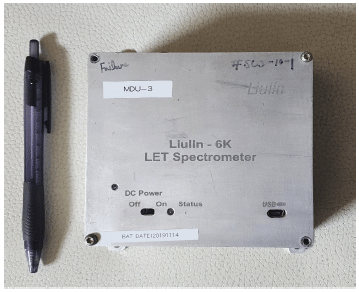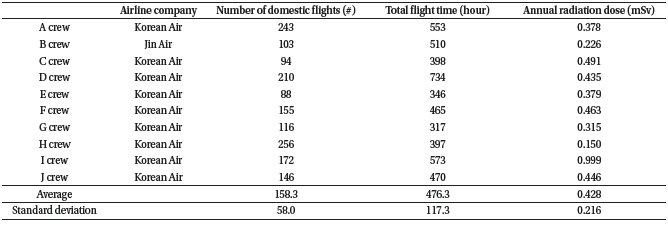1. INTRODUCTION
Cosmic radiation exposure of flight crews has been managed by the Radiation Safety Management around Living Life Act (hereafter ‘Radiation Safety Act’) since 2013 in Korea. Article 18 of the Act stipulates how to manage cosmic radiation exposure. Article 9 of the Enforcement Decree covers the scope of air transport operators, and Article 10 deals with safety measures for flight crews. The Ministry of Land, Infrastructure, and Transport, which is in charge of airplane companies, supervises the radiation management of flight crews according to the related regulations. However, very recently, the Nuclear Safety and Security Commission promoted a law to unify the management system for the cosmic radiation safety of the flight crews, and a significant change in the cosmic radiation management system is expected.
The Nuclear Safety and Security Commission provides official guidelines for the safety management of cosmic radiation for flight crews, which Air Transport Operators must observe to reduce radiation exposure to flight crews from cosmic radiation (Nuclear Safety Commission 2020). But, there is a possibility of problems because this act is kind of a recommendation and not compulsory. In general, air routes with higher latitudes, higher altitudes, and longer flight times are exposed to more cosmic radiation (Ahn et al. 2020). Domestic flights have a flight altitude up to 8,800 m and a flight time of around one hour for one-way, but it is very notable that an annual accumulated flight time is so long due to too many flight numbers.
In this study, we suggested that the scope of air transport operators in Article 9 of the Radiation Safety Act, which was currently limited to the airline companies operating international air routes, should include the airline companies operating only domestic flights. To support this suggestion, we show that the cosmic radiation exposure of domestic flight crews could not be negligible. We statistically analyzed accumulated annual dose obtained from in-situ Liulin-6K measurements and estimation programs of the Civil Aviation Research Institute (CARI)-6M and Korean Radiation Exposure Assessment Model (KREAM) during the whole year of 2019.
2. METHODS
Due to the covid-19 in 2020, the domestic flight numbers rapidly decreased compared to the previous years and the total flight time also reduced accordingly. To see the normal situation’s radiation exposure, in this study, we used the flight information of the domestic flight data in 2019. We measured the route doses using Liulin-6K LET (Linear Energy Transfer) spectrometer during domestic flights departing from and arriving at Gimpo airport. We used the flight data for Jeju- Gimpo, Ulsan-Gimpo, and Gimhae- Gimpo air routes. To compare these in-situ measurements with calculation model outputs, we used well-known radiation estimation programs such as CARI-6/6M, Nowcast of Atmospheric Ionizing Radiation for Aviation Safety (NAIRAS), and KREAM (Hwang et al. 2010, 2014, 2020). The geographic flight information of domestic flights was obtained from airline companies. In 2019, the total domestic flight number departing from the Gimpo airport was 60,100 flights. This number decreased to 55,073 flights showing an 18% reduction in 2020 because of covid-19. Departing flights from Jeju international airport were 78,928 flights in 2019. It dropped to 68,029 flights showing a 14% reduction in 2020.
Similarly, departing flights from Gimhae airport is decreased from 23,554 flights to 21,837 flights, showing a 7% reduction as shown in Fig. 1. As a result, the flights departing from all major domestic airports seriously down from the previous year. Overall, the number of domestic flights significantly decreased, while the Gimpo-Jeju route slightly decreased and the Gimpo-Busan route increased.
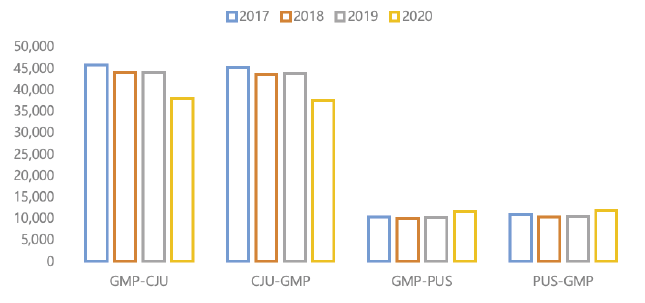
We used a Liulin-6K LET spectrometer for aviation radiation measurements onboard Korean commercial aircraft, which made the Bulgarian Academy of Sciences, Solar-Terrestrial Influences Laboratory (BAS-STIL). Liulin- 6K LET spectrometer is designed to measure aviation radiation exposure at an aircraft altitude using a silicon sensor (Fig. 2). Initially, it was developed for radiation exposure measurements in the international space station at low earth orbit. Still, now it is widely used to measure radiation exposure at an aircraft altitude.
The Korean Space Weather Center (KSWC) of the National Radio Research Agency has provided a public service of the aviation radiation information by the Safety during Aviation Flight Environment (SAFE) system (Fig. 3). This system allows the public to quickly check the radiation exposure for each person’s domestic and international air routes. The SAFE system provides radiation exposure doses from NAIRAS and CARI-6. The NAIRAS model, which developed NASA, provides quasi-real-time dose information by calculating the radiation exposure, taking into account the effects of galactic cosmic rays and solar cosmic rays. But CARI-6, which was developed by the Federal Aviation Administration (FAA), has been used more widely because of its ease of use. This CARI-6 has an apparent weakness that CARI-6 uses the monthly updated heliocentric potential (HCP), so the route dose is updated monthly. The FAA web page distributes the HCP value (FAA 1975) and the CARI-6 model considers only galactic cosmic rays. And the CARI-6 model has a critical weakness: real-time radiation exposure cannot be obtained because of delayed updates of the HCP value in the FAA web page (FAA 2014). The CARI-6M is a newly improved version of the CARI-6 model, including the waypoints setting function. In this study, we use the CARI-6M model to compare the observations. Actually, in Korea, most airline companies use the CARI-6M model to estimate the annual radiation exposure of crews, which is an obligation for them. Korean Air, Asiana airline, and some low-cost carriers (LCCs) such as Jeju Air, Jin Air, and Air Busan use the CARI-6M model. The other LCCs such as Eastar Jet, T’way Air, Air Seoul, and Air Incheon use the NAIRAS model result from the SAFE system. CARI-6M model is selected because that is provided only freely by the providers, FAA, to the users such as the Airline companies.
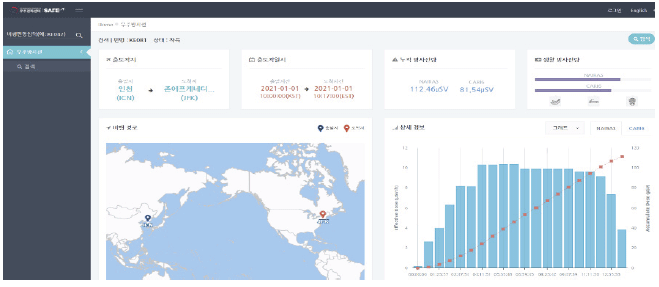
The KREAM is a cosmic radiation estimation model which is developed by Korea Astronomy and Space science Institute (KASI) and Korea Meteorological Administration (KMA 2015). KREAM considers galactic and solar cosmic rays by using realtime proton observations at geosynchronous orbit. KREAM is a more improved model than previous models such as CARI-6 and NAIRAS because it can include the instantaneous variation of space weather within a brief update period of about five minutes of proton observations by geosynchronous satellites (Hwang et al. 2010, 2014, 2020). Currently, KREAM uses proton observation from GOES-R satellite data, but it is planning to update to use GK-2A data soon.
The International Commission on Radiological Protection (ICRP) published the ICRP Publication 60, which firstly recommended that flight crews be managed as radiation workers (ICRP 1990). It also requires preparing a calculation program to reduce the estimated amount of annual radiation exposure for flight crews exposed to more than one mSv per year, which is the annual dose limit for the public. And in Korea, the commercial aircrafts flying above the altitude of 15 km must be equipped with the instrument for cosmic radiation measurement. However, it does not impose any restrictions on domestic air routes and establishes standards for measuring radiation exposure doses.
In November 2005, the World Health Organization (WHO) provided the information sheet about the effects of cosmic radiation on the human body, including recommendations on protecting the flight crews from radiation exposure (Lee et al. 2009).
The European Union distributed the COUNCIL DIRECTIVE 96/29 / EURATOM for Article 42, which recommended protecting the flight crews from cosmic radiation (The Council of the European Union 1996).
In the United States, cosmic radiation research has been actively carried out with space projects since the late 1960s. The FAA was also interested in the exposure of flight crews to cosmic radiation, and the Advisory Committee issued its first recommendations in 1975 (FAA 1975). Currently, for in-flight radiation exposure, Advisory Circular 120-61B (AC 120-61B) explains the cosmic radiation exposure of flight crews at aircraft altitudes.
3. ANALYSIS
According to the 2019 radiation safety management survey report conducted by Nuclear Safety Foundation (NSF), the average annual dose of all the flight crews in Korea is 1.71 mSv based on CARI-6M (http://airportal. go.kr). Major airline companies have many long-distance international flights at high latitudes and high altitudes. Still, LCCs are generally exposed to low levels due to most flights at relatively lower latitudes and shorter flight times, as shown in Table 1. However, the problem is that the exposure dose does not include the exposed by the flight crews during domestic flights because the recording of the domestic flight radiation exposure has not been compulsory for the airline companies until now.

|
In 2019, the statistical result for the flight data of ten domestic flight crews was listed in Table 2. In 2020, due to Covid-19, travel was seriously reduced in society, and domestic flight crews’ flight hours were dramatically reduced, so we analyzed the flight data only for 2019 for rational analysis. Most domestic flight crews showed the number of domestic flights from 100 to 250 times per year, and the average annual exposure dose was found to be 0.5– 0.8 mSv. With this level of exposure, it is expected that the domestic exposure will result in a result that appears close 1mSv, which is the annual radiation dose limit for the public.
The radiation exposure doses of the major domestic routes of the Gimpo-Jeju and Gimpo-Gimhae were analyzed with three models of NAIRAS, CARI-6, and KREAM in Table 3. NAIRAS provides 0.60–0.61 μSv for Gimpo-Jeju route, 0.99– 1.36 μSv for Jeju-Gimpo route, 0.68–1.17 μSv for Gimpo- Gimhae route, and 0.63–0.98 μSv for Gimhae-Gimpo route, while CARI-6 shows at least 21%–53% lower than NAIRAS. In other words, NAIRAS has an average of 33% higher than CARI-6. KREAM is relatively similar to NAIRAS, and shows about 6% lower than NAIRAS on average. KREAM calculates the radiation exposure dose, on average 28% higher than CARI-6. Both NAIRAS and KREAM models consider both the solar cosmic ray and galactic cosmic ray, whereas CARI- 6 considers only the galactic cosmic ray.
We also performed the in-situ measurements of radiation dose rate above the Korean peninsula by using the Liulin-6K instrument. The results are shown in Fig. 4. The route doses for Gimpo-Jeju , Jeju-Gimpo, Gimpo-Ulsan, Ulsan-Gimpo are 0.66, 0.59, 0.42, and 0.26 μSv each. This is similar to the model output.
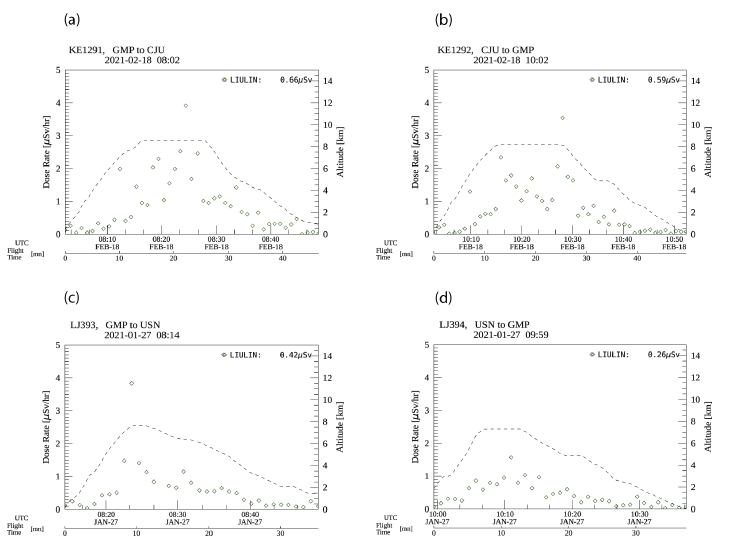
4. RESULTS AND ANALYSIS
We performed the statistical comparison study for domestic flights crews based on 2019 flight information and measurement for Gimpo-Jeju, Jeju-Gimpo, Gimpo- Ulsan, and Ulsan-Gimpo air routes by using the Liulin- 6K. As a result, we found that the radiation exposure dose for domestic flights cannot be neglected because of the following things.
First, despite the low altitude near 8,000 m and short oneway flight time of about one hour in the domestic air route, each route showed an exposure doses from 0.26 to 0.66 μSv. NAIRAS shows the radiation route dose from 0.6 to 1.36 μSv, while CARI-6 shows that to be from 0.30 to 0.86 μSv, and KREAM from 0.65 to 0.99 μSv. NAIRAS shows the value an average of 33% higher than CARI-6. KREAM indicators about 6% lower than NAIRAS on average. These differences between model output values can be interpreted as originating from the fact that both NAIRAS and KREAM models consider both the solar cosmic and galactic cosmic rays. In contrast, CARI-6 only considers the galactic cosmic ray.
Second, the annual average number of domestic flights suppose of small aircraft flight crews, mainly flying domestic flights, is about 100 to 250 times. At the annual radiation exposure doses is about 0.081 to 0.162 mSv based on the KREAM model calucation. If the radiation exposures for the international flights are added, the average exposure doses will be higher than currently known values and the resulting public’s exposure might be closer to 1 mSv, which is the annual dose limit for the general public.
Third, reviewing overseas regulations, the dose limits of 6 mSv per year and the obligation of keeping radiation exposure records up to 30 years or 75 years of age after retirement are recommended to protect the flight crews against space radiation. The Nuclear Safety and Security Commission is in the process of revising the relevant laws, but as a result of reviewing international regulations, it is not reasonable to exclude domestic expose dose.
Fourth, as a cosmic radiation prediction program, NAIRAS and CARI-6/6M/7/7A models were announced by the Nuclear Safety and Security Commission. At the same time, the domestically developed “KREAM” has different characteristics and produces various dose values. The significant difference between the model values makes it difficult for the flight attendants to use. Therefore, it would be desirable not to use different prediction programs for each airline but to use a unified standard program suitable for the situation in Korea to manage the radiation safety of the flight crews and passengers against space radiation.
Fifth, at the beginning of a new solar cycle 25, recent solar activity warnings are frequently issued. Since this affects the entire earth, the management of cosmic radiation exposure, which is applied only to international flights under the current law, should be expanded to domestic flights.
5. CONCLUSIONS
This study shows that the exposure dose received by flight crews on domestic flights is relatively small compared to international flight. The statistical analysis results for the international flights are shown at previous reports of Hwang et al. (2010, 2014, 2020). But since the number of flights is large and the flight time is not short, the accumulated exposure dose received by domestic flight crews annually is not negligible. Therefore, the radiation exposure dose records should be managed totally for all the flight crews, including both domestic and international.
In addition, in the case of the general public who frequently travels domestically and internationally for business purposes, the accumulated dose might be close to 1 mSv, so it is necessary to provide precise space radiation exposure information per each travel for the radiation protection of the people.










